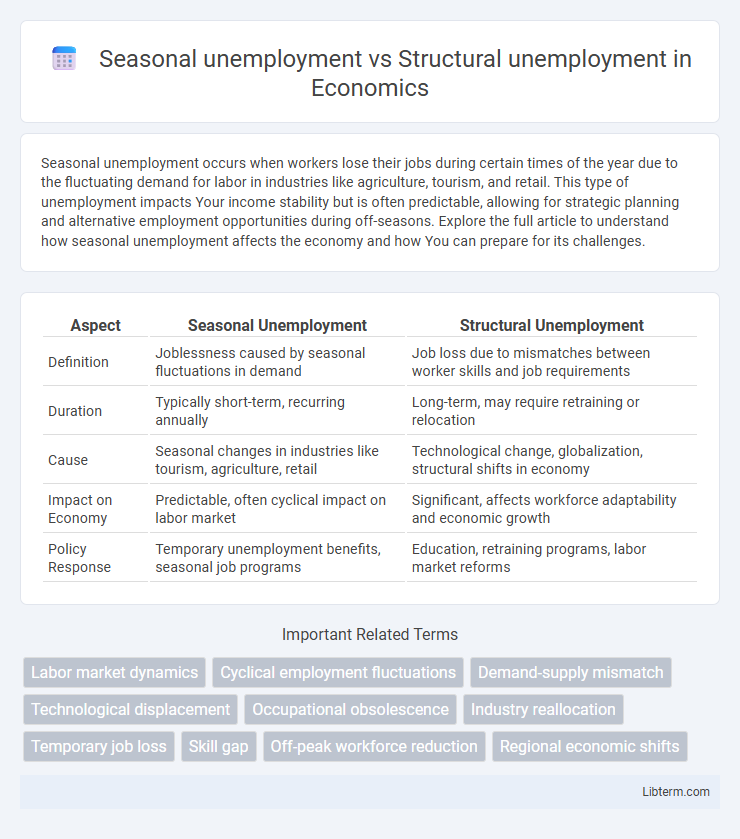Seasonal unemployment occurs when workers lose their jobs during certain times of the year due to the fluctuating demand for labor in industries like agriculture, tourism, and retail. This type of unemployment impacts Your income stability but is often predictable, allowing for strategic planning and alternative employment opportunities during off-seasons. Explore the full article to understand how seasonal unemployment affects the economy and how You can prepare for its challenges.
Table of Comparison
| Aspect | Seasonal Unemployment | Structural Unemployment |
|---|---|---|
| Definition | Joblessness caused by seasonal fluctuations in demand | Job loss due to mismatches between worker skills and job requirements |
| Duration | Typically short-term, recurring annually | Long-term, may require retraining or relocation |
| Cause | Seasonal changes in industries like tourism, agriculture, retail | Technological change, globalization, structural shifts in economy |
| Impact on Economy | Predictable, often cyclical impact on labor market | Significant, affects workforce adaptability and economic growth |
| Policy Response | Temporary unemployment benefits, seasonal job programs | Education, retraining programs, labor market reforms |
Understanding Seasonal Unemployment
Seasonal unemployment occurs when workers lose jobs due to regular, predictable fluctuations in demand tied to seasons, such as agriculture, tourism, or holiday retail. This type of unemployment is temporary and cyclical, with employment rising during peak seasons and falling during off-peak times, reflecting industry-specific labor needs. Understanding seasonal unemployment helps businesses plan workforce management and policymakers design targeted unemployment benefits and retraining programs.
What Is Structural Unemployment?
Structural unemployment occurs when there is a mismatch between the skills workers possess and the skills demanded by employers, often due to technological advances or changes in industry. It can persist long-term because affected workers may need retraining or to relocate to find suitable jobs. Seasonal unemployment, by contrast, arises from regular, predictable fluctuations in labor demand tied to seasons or industries like agriculture and tourism.
Key Differences Between Seasonal and Structural Unemployment
Seasonal unemployment occurs due to regular fluctuations in demand related to specific times of the year, such as agriculture, tourism, or retail during holidays, making it temporary and predictable. Structural unemployment arises from long-term changes in the economy, like technological advancements or shifts in industries, leading to a mismatch between workers' skills and job requirements. Unlike seasonal unemployment, which is cyclical and short-term, structural unemployment requires retraining or relocation to address persistent joblessness.
Causes of Seasonal Unemployment
Seasonal unemployment arises primarily from predictable fluctuations in labor demand due to seasonal changes in industries such as agriculture, tourism, and retail, which require more workers during peak periods and fewer during off-seasons. Factors like weather conditions, holiday seasons, and agricultural cycles significantly influence these employment patterns. Unlike structural unemployment, seasonal unemployment is temporary and recurs in a regular pattern based on the time of year.
Causes of Structural Unemployment
Structural unemployment arises from fundamental shifts in an economy, such as technological advancements, automation, and changes in consumer demand, leading to a mismatch between workers' skills and job requirements. Unlike seasonal unemployment, which fluctuates based on predictable cyclical patterns in industries like agriculture or tourism, structural unemployment results from long-term changes in industry composition and geographic distribution of jobs. The decline of certain sectors, globalization, and inadequate education or training systems further exacerbate structural unemployment by limiting workers' ability to transition to emerging industries.
Seasonal Unemployment: Examples and Industries Affected
Seasonal unemployment occurs when demand for labor fluctuates with seasons, commonly affecting agriculture, tourism, and retail industries; for example, agricultural workers face layoffs post-harvest, while retail jobs surge during holiday seasons. Construction and hospitality sectors also experience seasonal dips due to weather changes and travel patterns impacting workforce needs. This type of unemployment contrasts structural unemployment, which stems from fundamental shifts in the economy or technology rather than seasonal cycles.
Structural Unemployment: Examples and Real-World Cases
Structural unemployment arises from fundamental shifts in the economy that alter the demand for specific skills, often caused by technological advancements or globalization, leading to long-term job displacement. Examples include the decline of coal mining jobs due to automation and the outsourcing of manufacturing positions to countries with cheaper labor costs. Real-world cases such as the Rust Belt in the United States illustrate structural unemployment, where workers struggle to find employment matching their skill sets amidst industrial decline.
Economic Impact of Seasonal vs Structural Unemployment
Seasonal unemployment causes predictable fluctuations in labor demand, primarily affecting industries like agriculture, tourism, and retail, leading to temporary income instability and reduced consumer spending during off-peak periods. Structural unemployment arises from mismatches between workers' skills and job requirements, often resulting in prolonged joblessness, decreased productivity, and increased social welfare costs. The economic impact of structural unemployment is more severe and long-term, hindering economic growth, while seasonal unemployment has cyclical effects that typically resolve as demand returns.
Policy Solutions for Seasonal and Structural Unemployment
Policy solutions for seasonal unemployment focus on improving workforce flexibility through temporary job placement programs and promoting diversification in regions dependent on seasonal industries such as agriculture and tourism. Structural unemployment requires long-term strategies involving investment in education and vocational training to equip workers with skills aligned with evolving technological demands and industry shifts. Government initiatives like reskilling programs and incentives for innovation-driven sectors enhance labor market adaptability, addressing mismatches in skills and job availability.
Future Trends in Unemployment Types
Seasonal unemployment is expected to fluctuate with industry-specific cycles such as agriculture, tourism, and retail, while structural unemployment may rise due to rapid technological advancements and automation reshaping job requirements. Future trends indicate a growing need for workforce reskilling and upskilling to address skill mismatches caused by structural changes in the economy. Policymakers and businesses must invest in continuous education and adaptive labor market strategies to mitigate long-term structural unemployment challenges.
Seasonal unemployment Infographic

 libterm.com
libterm.com